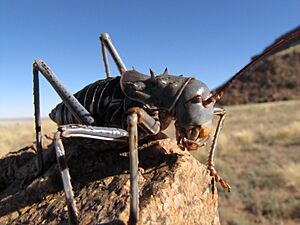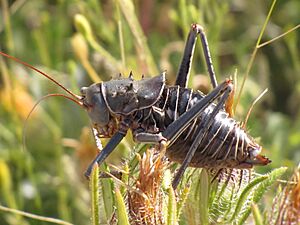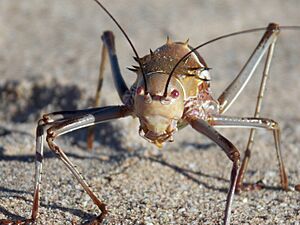Armoured katydid facts for kids
Quick facts for kids Armoured katydid |
|
|---|---|
 |
|
| Conservation status | |
| Scientific classification | |
| Synonyms | |
|
Hetrodes discoidalis Walker, 1869 |
The Acanthoplus discoidalis is a unique insect. It belongs to the Hetrodinae group, which is part of the larger Tettigoniidae family. This family is commonly known as katydids. You might hear this insect called by many names, like armoured katydid, armoured ground cricket, corn cricket, or koringkriek.
It's important to know that even though some names include "cricket," this insect is not a true cricket. True crickets are from a different insect family. The Acanthoplus discoidalis lives in parts of Angola, Namibia, Botswana, Zimbabwe, and South Africa.
Contents
What Does the Armoured Katydid Look Like?
The Acanthoplus discoidalis is a large, sturdy insect. It cannot fly and has a wide body. These katydids usually grow to be about 5 centimeters (almost 2 inches) long.
Their back, called the pronotum, has several sharp, pointy spines. These spines give them their "armoured" name. They also have very strong jaws, called mandibles. These jaws can give a painful bite. They also help the katydid eat tough plants or even dead animals.
What Do Armoured Katydids Eat?
Armoured katydids are omnivorous. This means they eat both plants and animals. They are also opportunistic eaters. This means they will eat many different kinds of food they find.
For example, some have been seen attacking baby birds in nests. Scientists think the katydids might find these nests by listening for sounds.
Sometimes, if they don't get enough protein or salt from their food, these katydids will eat each other. This happens a lot when there are many of them, especially in autumn. If some are run over by cars on roads, others will gather to eat them. This can lead to more katydids being run over too.
How Do Armoured Katydids Defend Themselves?
The Acanthoplus discoidalis has several ways to protect itself from danger. Their tough, spiny body is one defense. But they have other tricks too. How they defend themselves can depend on if they are male or female, and how they are attacked.
If an attacker comes from the side, both male and female katydids will try to bite. Males will also make a loud noise by rubbing parts of their body together. This is called stridulation. Females cannot make this noise.
About half the time, when attacked from the side, both males and females might squirt out a special liquid. This is called reflex bleeding or "autohaemorrhaging." They squirt their insect blood, called haemolymph, from small holes in their skin. They can shoot this liquid a few centimeters away.
If attacked from above, where they can't easily bite, they squirt out even more haemolymph.
Scientists have found that this haemolymph tastes bad to some reptiles. This helps keep predators away. The bad taste might come from chemicals in the plants the katydids eat. They might store these chemicals in their bodies to use for defense.
After squirting the liquid, the katydids carefully clean themselves. This might stop other katydids from trying to eat them. Research shows that this reflex bleeding is a controlled defense, not just an accident. Another defense they use is to throw up their stomach contents. This often happens if they have been attacked many times.
Reproduction and Life Cycle
The mating process for Acanthoplus discoidalis is quite slow. It usually begins when the sun sets and finishes by the time the sun rises.
A female katydid must mate before she can lay her first batch of eggs. After that, she can mate and lay eggs again in any order. For male katydids, it's better to mate with a female who hasn't laid eggs before. This is because more of the babies will be theirs. Females who haven't mated yet are lighter than those who have. So, males tend to mate more often with these lighter, new females. They also transfer their sperm packet faster to them.
Controlling Armoured Katydids
The Acanthoplus discoidalis can be a problem for farmers in Southern Africa. They often damage crops like sorghum and millet. In bad years, they can destroy up to 40% of a crop.
Farmers can use insecticides to control them. But because these katydids cannot fly, there's an easier way. Farmers can dig a trench (a ditch) about 50 centimeters (20 inches) deep around their fields. This traps the katydids. Sometimes, poisoned bait is put in these trenches to help control them even more.
Some people have even suggested that these katydids could be collected. They could then be used as a high-protein food for chickens.
Images for kids





